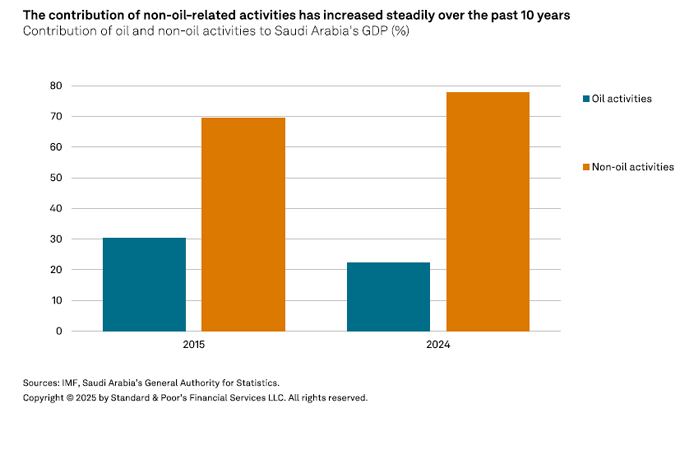Saudi Arabia doubles down on mining, says report

INDUSTRIAL NEWS
Saudi Arabia's long-term economic growth will increasingly rely on the metals and mining sector, says an S&P Global report.
This development is in line with the Vision 2030 programme, which aims to reduce the country's oil dependency, it says.
"Saudi Arabia's proactive measures and substantial resources may help offset continued cost pressures and support the resilience of metals and mining companies' credit profiles," S&P Global Ratings credit analyst Hina Shoeb says.
Unlike some global peers, Saudi metals and mining companies benefit from strong government support, new regulatory frameworks--such as the Mining Investment Law--and significant government-led capital investments in mega projects and domestic infrastructure, the report says.
"We expect these initiatives will spur domestic demand for metals, reduce import dependency, and over time improve the sector's operational efficiency. They will also support the domestic metals and mining sector's capacity to meet rising global demand, notably for base metals and minerals," the report continues.
Yet the sector suffers from strict regulations, harsh operating and environmental conditions, insufficient infrastructure, global commodity price fluctuations, and stiff competition, it notes.
The mining sector currently accounts for about 1.5% of Saudi Arabia's GDP. The Saudi government aims to increase mining companies' GDP contribution to $75 billion by 2030, from approximately $17 billion in 2024, it says.
The country boasts large reserves of metals and minerals that the world needs in large quantity in the future. Base metals--including copper, nickel, and lithium--are critical for the energy transition, while minerals, for example phosphate fertilisers, are essential for food safety.
Saudi Arabia's internal industrial growth is central to this transformation. "We expect that
sustained momentum in Vision 2030 investments and associated activity in construction,
logistics, domestic manufacturing, and mining will lead to an average headline GDP growth of
about 4% over 2025-2028," the report says.
The Saudi government aims to invest $40 billion annually in local giga and mega projects via the Public Investment Fund (PIF). As investments in infrastructure and manufacturing rise, local demand for metals will increase substantially, it says.
Government initiatives, such as the investment of close to SAR29 billion ($7.7 billion)
in the Wa'ad Al-Shamal project, with a focus on phosphates and a $100 billion funding plan
targeting critical minerals by 2035, intend to reduce import dependency and stimulate domestic
production. These funding measures are critical to support Saudi Arabia's internal growth and,
with that, its economic diversification.
Industrial growth could fuel domestic demand
Domestic industrial expansion is key to increase the local demand for metals. Giga projects--such as Neom, Red Sea, Qiddiya, Roshn, and Diriyah, among others--can transform Saudi Arabia's
urban landscapes and boost the demand for construction materials and high-value metals.
For example, Neom's integrated industrial clusters and Qiddiya's focus on sectors such as
entertainment, travel and tourism, utilities, hospitality, and transportation are projected to ramp up the local consumption of steel, aluminum, and copper.
These projects, which benefit from funding and infrastructure investments, aim to reduce the
country's import costs for metals (including iron, steel, precious and semi-stones), by creating a solid domestic market for metals and minerals. Import costs stood at about $20 billion- $24 billion for 2024 as per the General Authority for Statistics (GASTAT).
Saudi Arabia's metals and mining sector also benefits from the country's geographic position, with access to important markets in Europe, Asia, and Africa representing a competitive advantage.
Still, the large scale development of the sector hinges on the implementation of clear and
predictable regulations, notably on openness in international contracts, or ease for foreign
investors to partner with local companies and government entities to gain access to resources,
expertise, and market knowledge.
Untapped reserves spell opportunity
Saudi Arabia possesses vast, yet underexploited, mining and mineral resources. Current estimates value these reserves at approximately SAR9.375 trillion ($2.5 trillion), marking a 90% increase from the valuation of SAR5 trillion ($1.3 trillion) in 2016. This upward revision incorporates newly discovered rare earth elements and transitional metals, along with significant increases in phosphate ore, copper, zinc, and gold reserves.
Saudi Arabia's Western Region--dominated by the Arabian Shield, the Red Sea coastal plain, and
volcanic fields--hosts most of the country's mines, while the northern area is rich in phosphate deposits. These geological advantages provide a solid foundation for future exploration and production activities. - TradeArabia News Service
